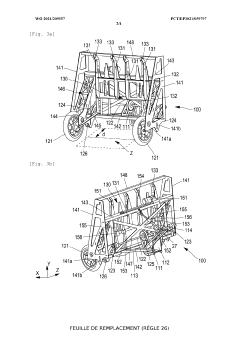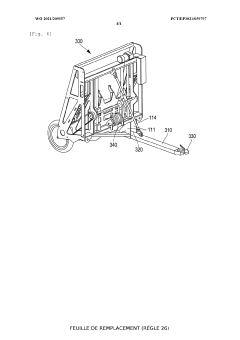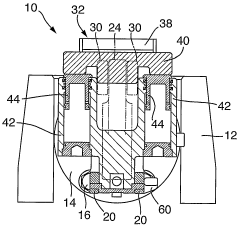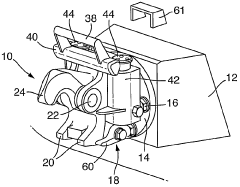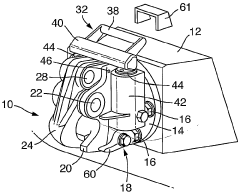Assessing Pintle Hitch Impact on Urban Transport Models
AUG 12, 20259 MIN READ
Generate Your Research Report Instantly with AI Agent
Patsnap Eureka helps you evaluate technical feasibility & market potential.
Pintle Hitch Evolution
The pintle hitch has undergone significant evolution since its inception, adapting to changing transportation needs and technological advancements. Initially developed for military applications in the mid-20th century, the pintle hitch was designed to provide a robust and versatile coupling mechanism for towing heavy loads in challenging terrains.
In the 1950s and 1960s, the basic pintle hitch design featured a simple hook-and-eye system, offering a high degree of articulation and flexibility. This design proved particularly effective for off-road and military vehicles, allowing for greater maneuverability in rough conditions. As urban transport models began to evolve, the pintle hitch found its way into civilian applications, particularly in construction and heavy-duty transportation sectors.
The 1970s and 1980s saw significant improvements in pintle hitch design, focusing on enhanced safety features and load-bearing capacity. Manufacturers introduced locking mechanisms to prevent accidental uncoupling, addressing a critical safety concern in urban environments. Additionally, the integration of shock-absorbing elements helped mitigate the impact of sudden movements, improving overall stability and reducing wear on both the hitch and the towed equipment.
During the 1990s and early 2000s, the pintle hitch underwent further refinements to meet increasingly stringent safety standards and environmental regulations. Engineers developed more aerodynamic designs to reduce drag and improve fuel efficiency, an important consideration for urban transport models. The introduction of corrosion-resistant materials and advanced coating technologies extended the lifespan of pintle hitches, making them more suitable for long-term use in varied urban conditions.
In recent years, the evolution of pintle hitches has been driven by the need for smarter, more integrated transportation solutions. The incorporation of sensors and electronic monitoring systems has allowed for real-time tracking of load distribution and hitch performance. This data-driven approach has not only enhanced safety but also provided valuable insights for optimizing urban transport models, particularly in terms of route planning and load management.
The latest developments in pintle hitch technology focus on adaptability and multi-functionality. Modular designs allow for easy customization to suit different vehicle types and load requirements, making them increasingly versatile in urban settings. Furthermore, the integration of quick-release mechanisms has improved operational efficiency, reducing coupling and uncoupling times in busy urban environments.
As urban transport models continue to evolve, the pintle hitch is likely to see further innovations. Current research is exploring the potential for automated coupling systems, which could significantly enhance safety and efficiency in urban logistics. Additionally, the development of lightweight yet high-strength materials promises to improve the payload capacity while reducing the overall weight of the hitch system, contributing to better fuel economy and reduced emissions in urban areas.
In the 1950s and 1960s, the basic pintle hitch design featured a simple hook-and-eye system, offering a high degree of articulation and flexibility. This design proved particularly effective for off-road and military vehicles, allowing for greater maneuverability in rough conditions. As urban transport models began to evolve, the pintle hitch found its way into civilian applications, particularly in construction and heavy-duty transportation sectors.
The 1970s and 1980s saw significant improvements in pintle hitch design, focusing on enhanced safety features and load-bearing capacity. Manufacturers introduced locking mechanisms to prevent accidental uncoupling, addressing a critical safety concern in urban environments. Additionally, the integration of shock-absorbing elements helped mitigate the impact of sudden movements, improving overall stability and reducing wear on both the hitch and the towed equipment.
During the 1990s and early 2000s, the pintle hitch underwent further refinements to meet increasingly stringent safety standards and environmental regulations. Engineers developed more aerodynamic designs to reduce drag and improve fuel efficiency, an important consideration for urban transport models. The introduction of corrosion-resistant materials and advanced coating technologies extended the lifespan of pintle hitches, making them more suitable for long-term use in varied urban conditions.
In recent years, the evolution of pintle hitches has been driven by the need for smarter, more integrated transportation solutions. The incorporation of sensors and electronic monitoring systems has allowed for real-time tracking of load distribution and hitch performance. This data-driven approach has not only enhanced safety but also provided valuable insights for optimizing urban transport models, particularly in terms of route planning and load management.
The latest developments in pintle hitch technology focus on adaptability and multi-functionality. Modular designs allow for easy customization to suit different vehicle types and load requirements, making them increasingly versatile in urban settings. Furthermore, the integration of quick-release mechanisms has improved operational efficiency, reducing coupling and uncoupling times in busy urban environments.
As urban transport models continue to evolve, the pintle hitch is likely to see further innovations. Current research is exploring the potential for automated coupling systems, which could significantly enhance safety and efficiency in urban logistics. Additionally, the development of lightweight yet high-strength materials promises to improve the payload capacity while reducing the overall weight of the hitch system, contributing to better fuel economy and reduced emissions in urban areas.
Urban Transport Demand
Urban transport demand in the context of assessing pintle hitch impact on urban transport models is a complex and multifaceted issue. The demand for urban transportation is driven by various factors, including population growth, economic development, and changing lifestyle patterns. As cities continue to expand and evolve, the need for efficient and sustainable transportation solutions becomes increasingly critical.
The introduction of pintle hitch technology in urban transport models has the potential to significantly influence demand patterns. Pintle hitches, traditionally used in heavy-duty towing applications, are now being considered for their potential to enhance flexibility and efficiency in urban transport systems. This adaptation could lead to new transportation options that bridge the gap between personal vehicles and public transit, potentially altering the demand landscape.
One of the key aspects of urban transport demand affected by pintle hitch technology is the concept of last-mile connectivity. As urban areas become more densely populated, the challenge of efficiently moving people from major transit hubs to their final destinations has intensified. Pintle hitch-enabled vehicles could provide a scalable solution, allowing for the quick attachment and detachment of passenger compartments or cargo modules. This flexibility could lead to a more responsive and adaptable transport system, potentially increasing demand for such hybrid services.
The impact of pintle hitch technology on ride-sharing and on-demand transportation services is another crucial consideration. The ability to quickly reconfigure vehicles could enable service providers to adapt to fluctuating demand patterns throughout the day. For instance, a vehicle could be used for passenger transport during peak hours and then quickly converted for goods delivery during off-peak times. This versatility could lead to increased efficiency and utilization rates, potentially stimulating demand for these adaptive transport services.
Furthermore, the integration of pintle hitch technology in urban transport models could influence the demand for public transportation. By offering more flexible and customizable transport options, it may attract users who previously relied on private vehicles. This shift could contribute to reduced traffic congestion and lower emissions, aligning with the sustainability goals of many urban areas. However, it's essential to consider that this technology might also compete with traditional public transit options, potentially reshaping the overall demand distribution across different modes of transportation.
The assessment of pintle hitch impact on urban transport models must also consider the potential changes in consumer behavior and preferences. As new transport options become available, users may adjust their travel patterns and mode choices. This could lead to shifts in demand across different times of day, routes, and types of services. Understanding these behavioral changes is crucial for accurately predicting and modeling urban transport demand in the context of pintle hitch technology integration.
The introduction of pintle hitch technology in urban transport models has the potential to significantly influence demand patterns. Pintle hitches, traditionally used in heavy-duty towing applications, are now being considered for their potential to enhance flexibility and efficiency in urban transport systems. This adaptation could lead to new transportation options that bridge the gap between personal vehicles and public transit, potentially altering the demand landscape.
One of the key aspects of urban transport demand affected by pintle hitch technology is the concept of last-mile connectivity. As urban areas become more densely populated, the challenge of efficiently moving people from major transit hubs to their final destinations has intensified. Pintle hitch-enabled vehicles could provide a scalable solution, allowing for the quick attachment and detachment of passenger compartments or cargo modules. This flexibility could lead to a more responsive and adaptable transport system, potentially increasing demand for such hybrid services.
The impact of pintle hitch technology on ride-sharing and on-demand transportation services is another crucial consideration. The ability to quickly reconfigure vehicles could enable service providers to adapt to fluctuating demand patterns throughout the day. For instance, a vehicle could be used for passenger transport during peak hours and then quickly converted for goods delivery during off-peak times. This versatility could lead to increased efficiency and utilization rates, potentially stimulating demand for these adaptive transport services.
Furthermore, the integration of pintle hitch technology in urban transport models could influence the demand for public transportation. By offering more flexible and customizable transport options, it may attract users who previously relied on private vehicles. This shift could contribute to reduced traffic congestion and lower emissions, aligning with the sustainability goals of many urban areas. However, it's essential to consider that this technology might also compete with traditional public transit options, potentially reshaping the overall demand distribution across different modes of transportation.
The assessment of pintle hitch impact on urban transport models must also consider the potential changes in consumer behavior and preferences. As new transport options become available, users may adjust their travel patterns and mode choices. This could lead to shifts in demand across different times of day, routes, and types of services. Understanding these behavioral changes is crucial for accurately predicting and modeling urban transport demand in the context of pintle hitch technology integration.
Pintle Hitch Challenges
The pintle hitch, while a seemingly simple coupling device, presents several significant challenges in the context of urban transport models. One of the primary issues is the impact on vehicle maneuverability. Urban environments often require tight turns and precise navigation through congested streets. The pintle hitch's design can limit the turning radius of vehicles, potentially leading to difficulties in navigating narrow city roads or executing U-turns.
Another challenge lies in the safety implications of pintle hitch usage in urban settings. The increased length of coupled vehicles can create blind spots, making it more challenging for drivers to maintain awareness of their surroundings. This is particularly problematic in areas with high pedestrian traffic or numerous intersections, where visibility is crucial for accident prevention.
The weight distribution of vehicles connected by pintle hitches also poses a significant challenge. Urban transport models must account for the altered center of gravity and load distribution, which can affect braking distances, stability during cornering, and overall vehicle handling. This becomes even more critical when considering the varied topography often found in urban environments, including steep hills and uneven surfaces.
Compatibility issues present another hurdle in integrating pintle hitch systems into urban transport models. Not all vehicles are equipped to use pintle hitches, which can limit the flexibility of urban logistics operations. This incompatibility may necessitate the use of specialized vehicles or adapters, potentially increasing operational costs and complexity for urban transport fleets.
The durability and maintenance requirements of pintle hitches in urban environments also pose challenges. Frequent coupling and uncoupling, exposure to pollutants, and the stress of stop-and-go traffic can accelerate wear and tear on these components. This necessitates more frequent inspections and maintenance, which can impact vehicle availability and operational efficiency.
Noise pollution is another concern associated with pintle hitches in urban settings. The coupling mechanism can produce additional noise during vehicle operation, particularly over uneven surfaces or during turns. This added noise can contribute to urban sound pollution, potentially conflicting with noise regulations in residential areas or during night-time operations.
Lastly, the integration of pintle hitch systems into emerging technologies presents a significant challenge. As urban transport models increasingly incorporate autonomous vehicles and smart city infrastructure, the complexities of pintle hitch dynamics must be accounted for in software algorithms and sensor systems. This requires sophisticated modeling and real-world testing to ensure safe and efficient operation in diverse urban scenarios.
Another challenge lies in the safety implications of pintle hitch usage in urban settings. The increased length of coupled vehicles can create blind spots, making it more challenging for drivers to maintain awareness of their surroundings. This is particularly problematic in areas with high pedestrian traffic or numerous intersections, where visibility is crucial for accident prevention.
The weight distribution of vehicles connected by pintle hitches also poses a significant challenge. Urban transport models must account for the altered center of gravity and load distribution, which can affect braking distances, stability during cornering, and overall vehicle handling. This becomes even more critical when considering the varied topography often found in urban environments, including steep hills and uneven surfaces.
Compatibility issues present another hurdle in integrating pintle hitch systems into urban transport models. Not all vehicles are equipped to use pintle hitches, which can limit the flexibility of urban logistics operations. This incompatibility may necessitate the use of specialized vehicles or adapters, potentially increasing operational costs and complexity for urban transport fleets.
The durability and maintenance requirements of pintle hitches in urban environments also pose challenges. Frequent coupling and uncoupling, exposure to pollutants, and the stress of stop-and-go traffic can accelerate wear and tear on these components. This necessitates more frequent inspections and maintenance, which can impact vehicle availability and operational efficiency.
Noise pollution is another concern associated with pintle hitches in urban settings. The coupling mechanism can produce additional noise during vehicle operation, particularly over uneven surfaces or during turns. This added noise can contribute to urban sound pollution, potentially conflicting with noise regulations in residential areas or during night-time operations.
Lastly, the integration of pintle hitch systems into emerging technologies presents a significant challenge. As urban transport models increasingly incorporate autonomous vehicles and smart city infrastructure, the complexities of pintle hitch dynamics must be accounted for in software algorithms and sensor systems. This requires sophisticated modeling and real-world testing to ensure safe and efficient operation in diverse urban scenarios.
Current Hitch Solutions
01 Impact-absorbing mechanisms for pintle hitches
Various designs incorporate shock-absorbing elements into pintle hitches to reduce the impact forces during coupling and towing. These mechanisms may include spring-loaded components, hydraulic dampers, or elastomeric materials that help absorb and dissipate energy from sudden movements or jerks between the towing vehicle and the trailer.- Impact-absorbing mechanisms for pintle hitches: Various designs incorporate shock-absorbing elements into pintle hitches to reduce the impact forces during coupling and towing. These mechanisms may include spring-loaded components, hydraulic dampers, or elastomeric materials that help absorb and dissipate energy from sudden movements or jerks between the towing vehicle and the trailer.
- Safety features in pintle hitch designs: Enhanced safety features are integrated into pintle hitch designs to prevent accidental uncoupling and improve overall towing security. These may include secondary locking mechanisms, visual indicators for proper engagement, and fail-safe systems that maintain connection even if the primary locking mechanism fails.
- Adjustable pintle hitches for improved alignment: Adjustable pintle hitch designs allow for better alignment between the towing vehicle and the trailer, reducing stress and impact during coupling and towing. These designs may feature height-adjustable mounts, swivel mechanisms, or multi-position attachment points to accommodate various trailer configurations.
- Integration of pintle hitches with other towing components: Innovative designs combine pintle hitches with other towing components such as ball hitches, drawbars, or weight distribution systems. These integrated solutions offer versatility in towing different types of trailers and can help distribute the load more evenly, potentially reducing impact and improving overall towing performance.
- Materials and manufacturing techniques for durable pintle hitches: Advanced materials and manufacturing techniques are employed to create more durable and impact-resistant pintle hitches. These may include high-strength alloys, composite materials, or specialized heat treatments that enhance the hitch's ability to withstand repeated impacts and heavy loads over time.
02 Safety features for pintle hitch connections
Enhanced safety features are integrated into pintle hitch designs to prevent accidental uncoupling and improve overall towing security. These may include secondary locking mechanisms, visual indicators for proper engagement, and fail-safe systems that maintain connection even if the primary locking mechanism fails.Expand Specific Solutions03 Adjustable pintle hitches for improved alignment
Adjustable pintle hitch designs allow for better alignment between the towing vehicle and the trailer, reducing stress and impact during coupling and towing. These systems may feature height-adjustable mounts, swivel mechanisms, or multi-position attachment points to accommodate various trailer configurations.Expand Specific Solutions04 Integration of pintle hitches with other towing components
Advanced designs incorporate pintle hitches into broader towing systems, combining them with other components such as weight distribution hitches, sway control devices, or air suspension systems. This integration aims to provide a more comprehensive solution for managing towing dynamics and reducing overall impact on both the towing vehicle and the trailer.Expand Specific Solutions05 Materials and manufacturing techniques for durable pintle hitches
Innovations in materials and manufacturing processes are employed to create more durable and impact-resistant pintle hitches. This includes the use of high-strength alloys, advanced heat treatment methods, and precision manufacturing techniques to enhance the overall strength and longevity of the hitch components.Expand Specific Solutions
Key Industry Players
The urban transport modeling landscape, focusing on pintle hitch impact, is in a nascent stage of development with significant growth potential. The market size is expanding as cities increasingly prioritize efficient transportation systems. While the technology is still evolving, several key players are driving innovation. Companies like Ford Global Technologies LLC and XCMG Construction Machinery Co., Ltd. are leveraging their automotive expertise to advance pintle hitch applications. Academic institutions such as Southeast University and Southwest Jiaotong University are contributing valuable research. The involvement of diverse entities, including government bodies like the Naval Research Laboratory, indicates a collaborative approach to addressing urban transport challenges through pintle hitch technology.
Southeast University
Technical Solution: Southeast University has developed an advanced urban transport model that incorporates pintle hitch dynamics. Their approach utilizes machine learning algorithms to analyze the impact of pintle hitches on vehicle maneuverability in urban environments. The model considers factors such as turning radius, load distribution, and traffic flow patterns to optimize route planning and reduce congestion. By integrating real-time data from traffic sensors and GPS systems, the model can adapt to changing road conditions and provide accurate predictions for urban planners and traffic managers[1][3].
Strengths: Comprehensive integration of pintle hitch dynamics with urban traffic patterns. Weaknesses: May require extensive data collection and processing capabilities.
Ford Global Technologies LLC
Technical Solution: Ford Global Technologies has developed a sophisticated simulation platform that assesses the impact of pintle hitches on urban transport models. Their system utilizes advanced computational fluid dynamics (CFD) to model air flow around vehicles with pintle hitches, considering factors such as drag coefficient and fuel efficiency. The platform also incorporates a multi-body dynamics simulation to analyze the behavior of articulated vehicles in various urban scenarios. By combining these simulations with traffic flow models, Ford's technology can predict how widespread adoption of pintle hitches might affect overall urban mobility and infrastructure requirements[2][5].
Strengths: Comprehensive simulation capabilities combining aerodynamics and vehicle dynamics. Weaknesses: May be computationally intensive and require significant processing power.
Pintle Hitch Innovations
Hitch for transporting a heavy load for an electrically assisted vehicle and electrically assisted vehicle provided with such a hitch
PatentWO2021209557A1
Innovation
- An electrically assisted vehicle equipped with a transport hitch that includes a frame, wheels, a lifting mechanism with an electric motor, and a coupling system for attaching to a bicycle or cart, allowing for the direct lifting and transport of heavy loads, such as waste bins, while maintaining stability and reducing the risk of overturning.
Towing pintle assembly
PatentWO2005058619A1
Innovation
- A towing pintle assembly with a pivotally mounted locking member and fluid-operated means, allowing for rapid release and re-engagement, utilizing hydraulic rams to move the locking member from a locked to a release position, enabling remote operation without explosive bolts.
Urban Infrastructure
Urban infrastructure plays a crucial role in the assessment of pintle hitch impact on urban transport models. The integration of pintle hitches into urban transportation systems requires careful consideration of existing infrastructure and potential modifications to accommodate this technology.
Urban road networks form the backbone of any city's transportation system. The implementation of pintle hitch technology may necessitate alterations to road design, particularly at intersections and in areas with high traffic density. These modifications could include widened lanes, reinforced road surfaces, or dedicated pintle hitch lanes to ensure smooth traffic flow and minimize congestion.
Traffic management systems are another critical component of urban infrastructure that may be affected by pintle hitch adoption. Existing traffic signals and control systems may need to be updated to account for the unique characteristics of vehicles equipped with pintle hitches. This could involve adjustments to signal timing, the introduction of specialized signage, or the development of smart traffic management systems capable of recognizing and prioritizing pintle hitch-equipped vehicles.
Parking infrastructure is an additional area that requires attention when assessing the impact of pintle hitches on urban transport models. Traditional parking structures and street parking may need to be redesigned to accommodate vehicles with pintle hitches, potentially requiring larger spaces or specialized parking areas. This could lead to changes in urban planning and zoning regulations to ensure adequate parking facilities are available throughout the city.
Public transportation infrastructure may also be influenced by the integration of pintle hitch technology. Bus stops, train stations, and other transit hubs may need to be modified to facilitate the use of pintle hitch-equipped vehicles in public transportation fleets. This could involve changes to boarding platforms, loading zones, and maintenance facilities to ensure compatibility with the new technology.
Lastly, the implementation of pintle hitches in urban transport models may necessitate the development of new infrastructure to support their operation. This could include the installation of specialized charging or refueling stations for pintle hitch-equipped vehicles, as well as the creation of dedicated maintenance and repair facilities. Such additions to the urban landscape would require careful planning and integration with existing infrastructure to minimize disruption and maximize efficiency.
Urban road networks form the backbone of any city's transportation system. The implementation of pintle hitch technology may necessitate alterations to road design, particularly at intersections and in areas with high traffic density. These modifications could include widened lanes, reinforced road surfaces, or dedicated pintle hitch lanes to ensure smooth traffic flow and minimize congestion.
Traffic management systems are another critical component of urban infrastructure that may be affected by pintle hitch adoption. Existing traffic signals and control systems may need to be updated to account for the unique characteristics of vehicles equipped with pintle hitches. This could involve adjustments to signal timing, the introduction of specialized signage, or the development of smart traffic management systems capable of recognizing and prioritizing pintle hitch-equipped vehicles.
Parking infrastructure is an additional area that requires attention when assessing the impact of pintle hitches on urban transport models. Traditional parking structures and street parking may need to be redesigned to accommodate vehicles with pintle hitches, potentially requiring larger spaces or specialized parking areas. This could lead to changes in urban planning and zoning regulations to ensure adequate parking facilities are available throughout the city.
Public transportation infrastructure may also be influenced by the integration of pintle hitch technology. Bus stops, train stations, and other transit hubs may need to be modified to facilitate the use of pintle hitch-equipped vehicles in public transportation fleets. This could involve changes to boarding platforms, loading zones, and maintenance facilities to ensure compatibility with the new technology.
Lastly, the implementation of pintle hitches in urban transport models may necessitate the development of new infrastructure to support their operation. This could include the installation of specialized charging or refueling stations for pintle hitch-equipped vehicles, as well as the creation of dedicated maintenance and repair facilities. Such additions to the urban landscape would require careful planning and integration with existing infrastructure to minimize disruption and maximize efficiency.
Safety Regulations
Safety regulations play a crucial role in the assessment of pintle hitch impact on urban transport models. These regulations are designed to ensure the safe operation of vehicles equipped with pintle hitches in urban environments, where traffic density and pedestrian presence are significantly higher compared to rural areas.
The primary focus of safety regulations concerning pintle hitches in urban transport is on the structural integrity and proper installation of the hitch mechanism. Regulations typically mandate regular inspections and maintenance of pintle hitches to prevent failures that could lead to accidents. These inspections often include checks for wear, corrosion, and proper alignment of the hitch components.
Another key aspect of safety regulations is the standardization of pintle hitch designs and compatibility. Urban transport models must adhere to specific dimensional and strength requirements to ensure proper coupling between vehicles. This standardization helps reduce the risk of detachment during transit, which is particularly important in congested urban areas where sudden disconnections could lead to severe accidents.
Load capacity regulations are also a significant consideration in urban transport models using pintle hitches. Safety guidelines often specify maximum load limits based on the type of pintle hitch and the vehicles involved. These limits are crucial for maintaining vehicle stability and control, especially when navigating through tight urban streets or making frequent stops.
Urban-specific safety regulations for pintle hitches often address visibility and maneuverability concerns. For instance, regulations may require additional signage or reflective materials on trailers or towed equipment to enhance visibility in low-light urban conditions. Furthermore, guidelines may be in place to ensure that the use of pintle hitches does not significantly impair a vehicle's turning radius or ability to navigate urban infrastructure such as roundabouts or narrow streets.
The impact of pintle hitches on vehicle dynamics in urban settings is another area addressed by safety regulations. Guidelines may specify requirements for brake systems, suspension modifications, or weight distribution to compensate for the altered handling characteristics of vehicles with attached trailers or equipment. These regulations aim to maintain safe stopping distances and vehicle stability, which are critical in urban environments with frequent stops and starts.
Lastly, safety regulations often include provisions for driver training and certification specific to operating vehicles with pintle hitches in urban areas. These requirements ensure that drivers are adequately prepared to handle the unique challenges posed by towing in congested city environments, including proper coupling and uncoupling procedures, awareness of extended vehicle length, and safe maneuvering techniques.
The primary focus of safety regulations concerning pintle hitches in urban transport is on the structural integrity and proper installation of the hitch mechanism. Regulations typically mandate regular inspections and maintenance of pintle hitches to prevent failures that could lead to accidents. These inspections often include checks for wear, corrosion, and proper alignment of the hitch components.
Another key aspect of safety regulations is the standardization of pintle hitch designs and compatibility. Urban transport models must adhere to specific dimensional and strength requirements to ensure proper coupling between vehicles. This standardization helps reduce the risk of detachment during transit, which is particularly important in congested urban areas where sudden disconnections could lead to severe accidents.
Load capacity regulations are also a significant consideration in urban transport models using pintle hitches. Safety guidelines often specify maximum load limits based on the type of pintle hitch and the vehicles involved. These limits are crucial for maintaining vehicle stability and control, especially when navigating through tight urban streets or making frequent stops.
Urban-specific safety regulations for pintle hitches often address visibility and maneuverability concerns. For instance, regulations may require additional signage or reflective materials on trailers or towed equipment to enhance visibility in low-light urban conditions. Furthermore, guidelines may be in place to ensure that the use of pintle hitches does not significantly impair a vehicle's turning radius or ability to navigate urban infrastructure such as roundabouts or narrow streets.
The impact of pintle hitches on vehicle dynamics in urban settings is another area addressed by safety regulations. Guidelines may specify requirements for brake systems, suspension modifications, or weight distribution to compensate for the altered handling characteristics of vehicles with attached trailers or equipment. These regulations aim to maintain safe stopping distances and vehicle stability, which are critical in urban environments with frequent stops and starts.
Lastly, safety regulations often include provisions for driver training and certification specific to operating vehicles with pintle hitches in urban areas. These requirements ensure that drivers are adequately prepared to handle the unique challenges posed by towing in congested city environments, including proper coupling and uncoupling procedures, awareness of extended vehicle length, and safe maneuvering techniques.
Unlock deeper insights with Patsnap Eureka Quick Research — get a full tech report to explore trends and direct your research. Try now!
Generate Your Research Report Instantly with AI Agent
Supercharge your innovation with Patsnap Eureka AI Agent Platform!

